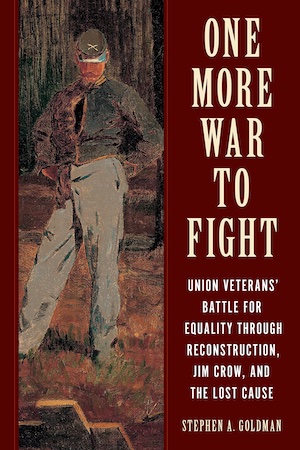By Allen D. Boyer
In One More War to Fight, a deeply researched, highly readable study of the most terrible war in American history, Stephen Goldman shows that it is not only Southerners, and not only traditionalists, over whose minds and memories the war exerted lasting power.
Goldman focuses on the “Left-Armed Corps”: 268 Union veterans who had lost their right arms to amputation. They submitted entries to contests seeking personal statements, to evidence their left-handed penmanship and continuing mental acuity. Army records suggest that these men are a fair cross-sample of the Union Army, meaning that their essays suggest what their two million serving comrades may have believed – about the war, about slavery, about the black troops who fought beside them, about race in 19th-Century America.
They were asked for handwriting samples; what they chose to say is striking. William Penn Sands of Ohio saw something more lasting than military victory: “We have as a people, [at] least now, the doctrine of a Higher Law, than man’s own enactment.” A sergeant from Vermont favored a railroad metaphor: “It is not enough merely to acknowledge emancipation and repudiate secession. In passing from the narrow gauge of slavery to [the] broad gauge of freedom . . . the whole dimensions and proportions of car and engine are to be remodeled.”
Perhaps most surprisingly, an Iowa lieutenant wrote that “although the intermarriage of Whites & Blacks is not in accordance with my taste . . . yet strictly speaking, if a white man chooses to marry a black woman, or the reverse, it is simply none of my business; nor is it any other man’s business.”
Veterans of the Left-Armed Corps often found their way into Freedmen’s Bureau posts and later into the Grand Army of the Republic. (Their pension files provide data for a lifelong longitudinal study.) Those who served the Freedmen’s Bureau, in the early days after the war, worked to build schools, found temperance associations, and enforce the new Civil Rights Act of 1866. In Warrenton, Virginia, just west of the battlefield of Manassas, William Augustus MacNulty called in federal cavalry to protect a school funded by the New England Freedmen’s Aid Society. Increasingly, the officers butted heads with local lawmen and court systems that sided with the white population.
Lieutenant-Colonel Joseph Gelray may have seen the most hazardous service. In early 1868, acting under orders from Ulysses Grant, Gelray investigated the nightriding violence that had overtaken middle Tennessee: floggings, attempted lynchings, shootings, riots. In Gelray’s native Massachusetts, newspapers supported him and denounced the man who oversaw the rising tide of Southern violence, Nathan Bedford Forrest. Elsewhere, however, memories of the war were rapidly fading. The national election of 1868 saw a hundred former Confederate officers seated at the Democratic convention, while conservative veterans, calling themselves “White Boys in Blue,” demanded the Bureau’s abolition as a drain on the national treasury.
In later chapters, the most powerful political lobby in American history battles against the most pernicious myth in American culture, as the Grand Army of the Republic resists the rise of the Lost Cause.
The GAR chose to recognize lodges of black veterans, in local “camps” of equal standing with white camps, against the demands of white Union veterans who had settled in the Deep South. The group’s national leadership planned to draw a color bar; the membership rejected it.
At the turn of the new century, when Robert E. Lee was becoming a national hero, GAR members resisted plans to install a statue of Lee in Statuary Hall of the United States Capitol. Aging black veterans in Brooklyn refused to march behind any Confederate survivors during a 1905 Memorial Day parade (which led to the Confederates dropping out). In Boston, in this same era, a Left-Armed Corps stalwart helped to commemorate a different cause: Colonel Gelray was on the dais at the unveiling of the memorial to the 54th Massachusetts and Colonel Robert Gould Shaw.
The lesson of Civil War trauma and service is eternal. The history of the Left-Armed Corps (also recently explored by Allison M. Johnson) is a notable chapter in this story. One More War to Fight ably examines the Civil War from an unaccustomed angle – a perspective that reflects Goldman’s experience as a psychiatrist, as well as his affection for history.
Allen D. Boyer (ΦBK, Vanderbilt University), is a lawyer and historian living on Staten Island. Vanderbilt University is home to the Alpha of Tennessee Chapter of Phi Beta Kappa.




